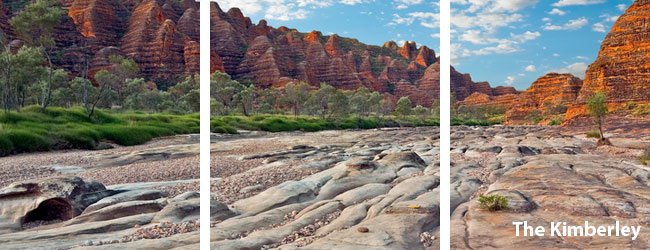Campervan in The Kimberley's - Outback Guide
Kimberley is one of the wildest and most remote regions on earth. Located in the northern part of Western Australia, The Kimberley's extend from Broome in the west, to Kununurra and Lake Argyle in the east. Covering a total area of 421,000 square kilometres, the vastness of this dramatic region is great and up to two weeks are needed to explore it.
The landscapes here are beautiful to say the least and are made up of ancient, steep-sided mountain ranges, sandstone and limestone gorges and dramatically steep ridges.
The highlights of the region include the gateway town of Broome, and its position on the picturesque waters of Cable Beach, the ancient inland river gorges, the intriguing working cattle stations located along the remote Gibb River Road and the mystical sandstone domes of the Bungle Bungles.
There really is so much to see and do within this region and the perfect way to experience it all is with a campervan, which will give you the freedom to take your time and absorb the pure and natural beauty that is the Kimberley.

Travel Distances
The best place to begin your campervan adventure in the Kimberley is in the gateway town of Broome. Situated 2,172 kilometres north of Western Australia's capital city, Perth, it's a bit of a drive but the scenery is well worth it. However, those wishing to take the coastal route should expect to travel at least 2,360 kilometres instead.
The drive from Darwin to the Kimberley town of Kununurra is approximately 830 kilometres, and takes around 10 hours to complete.
Driving distances across the Kimberley are also incredibly vast, with many distances between towns reaching some 500 kilometres.
Airports and Campervan Depots
There are two main airports tourists use to fly in for an adventure in the Kimberley's. Broome Airport and Darwin International Airport are both located near campervan depots and are ideal places to begin your campervan holiday in The Kimberley's.
Campervan travellers can choose to either pick up their vehicle from Broome or Darwin. A one-way rental is a popular option for those wishing to simply travel between the two and not backtrack on where they have already driven.
Park Use Fees
An entry fee is not required for entering the Kimberley region, yet there are several National Parks in the region for which an entrance fee is charged. This is generally charged per vehicle and is around $10. Alternatively you can purchase a Parks Pass, which will gain you entry into all of the fee paying parks within the Kimberley.
National Parks that charge entrance fees include:
- Bungle Bungles National Park
- Mitchell River National Park
A permit is required for visiting Kalumburu and if you plan on entering Aboriginal land. If you are visiting the Dampier Peninsula, a permit will also be required if you wish to visit some of the little-known eastern communities.
What to See and Do
Broome
"Where the sky meets the land, the desert meets the sea, where white sands, red rocks and cobalt waters come together, on a peninsula not more than 15 kilometres long" is the simplest sentence one could use to describe the seaside town of Broome.
As the southern gateway to the Kimberley, Broome is a truly remarkable place, oozing with charm, beauty and character.
Kununurra
Kununurra is an ideal base for those wishing to explore the east Kimberley region. From scenic natural wonders and rugged ridges, to the stunning waters of Lake Argyle, Kununurra seems to have it all. Spend some time exploring Mirima National Park (Hidden Valley), Kelly's Know Lookout and Elephant Rock (Sleeping Buddha).
Bungle Bungles
The Bungle Bungle Range is situated in the Purnululu National Park and is comprised of magnificent sandstone domes, striped with orange and grey bands that are truly spectacular visual sights. These unusual natural wonders are estimated to be around 350 million years old and are a sight to behold.
Wolfe Creek
Made famous by the movie of the same title, though visited by hoards of tourists before, Wolfe Creek is an intriguing meteorite crater that measures as the second largest in the world.
Wolfe Creek is located in the southern end of the Kimberley region and lies on the border of the Great Sandy Desert and the Tanami Desert.
Tunnel Creek
Tunnel Creek is a National Park of the Kimberley region, with its main attraction being a 750 metre long tunnel that is part of the most ancient cave system in Western Australia. Organised tours are a popular way to explore this natural wonder as it is only accessible with a 4WD vehicle.
Mitchell Falls and Mitchell Plateau
The Mitchell Falls are one of the most photographed attractions in the Kimberley region, and with good reason. These tiered falls can be found within a glorious National Park, which although takes a while to get to, is definitely worth the trip.
Climate and Weather
The Kimberley has a tropical monsoon climate and receives most of its rainfall in the west season, between November and April. Aside from the rain, the Kimberley is regarded as the hottest part of Australia, with mean maximum temperatures usually exceeding 30 degrees Celsius.
September to November is regarded as the "build-up" season and is when it begins to get hotter and more humid. Thunderstorms are a frequent occurrence in the afternoons.
The wet season takes full hold from December to March and rain tends to fall unevenly, which leads to frequent flooding. The weather in this season changes quickly, without any notice, so it is important to be prepared if you are looking to travel in this season.
Best Time to Visit
May to August is the main tourist season, and is when all the roads and attractions are open. This is a great time to travel here, if you don't mind the crowds. However, if you can handle the heat, another option is to travel in September or October, when most of the tourists have left and you can enjoy the true remoteness this area is known for.
What to wear?
During the day it can get incredibly hot in The Kimberley's, therefore it is best to dress in loose clothing that will still protect you from the sun and insect bites. Sunscreen, wide brimmed hats and sunglasses are necessities, while insect repellant is also essential to have on hand.
If you plan on swimming in the park (and most people tend to do so), be sure to put on plenty of sunscreen as the sun's rays are harsh and sunburn is almost guaranteed.
Wildlife
A unique diversity of wildlife can be found within the Kimberley region and the most prominent creature is without a doubt the saltwater crocodile.
A rich variety of birds also call the region home, including the Channel-billed Cuckoo, Pacific Koel and Purple-crowned Fairywren.
Frogs have also been known to frequent the area, with common favourites including the Flat-headed frog, cave-dwelling frog, Magnificent Tree Frog, and a range of Toadlets.
Windjana, Tunnel Creek and Geikie Gorges are also known for their bat colonies.
Pure dingoes are common within the Kimberley, while nine species of kangaroos and wallabies can also be found here.
Driving Restrictions and Tips
Unfortunately rental campervans and 4WDs are not permitted on the Gibb River Road or in the Bungle Bungles. Essentially, this means you will have to stick to the Great Northern Highway/Savannah Way for your adventure in the Kimberley's. However, Savannah Way from Normanton to Borroloola is also restricted by campervan rental companies.
During the wet season, the roads in the Kimberley have been known to flood, so if this occurs while you are travelling, it is best to wait until the waters recede before you continue your travels.
As with driving anywhere in the outback, it is important to drive carefully at night and always keep an eye out for wildlife.
What to bring?
It is absolutely necessary to bring plenty of water to The Kimberley's, regardless of the length of your stay. Ensuring you always have fuel in your petrol tank is also important as distances between roadhouses can be vast.
Appropriate clothing, sun protection, insect repellant and shoes are also vital, because of the changing weather conditions. This is the outback, so remember it gets extremely hot!
It is also a good idea to bring a suitable amount of food. The shops around here are quite expensive, so it works out a lot cheaper to bring your own in.
Another must-have for your campervan adventure in The Kimberley's is your camera. The landscapes here are unlike anywhere else in the world so you will want to remember your memories of this place.
Places to Stay
El Questro Station and Wilderness Park is by far the most comfortable place to stay in the Kimberley region. Located on the banks of the Pentecost River, this station offers secluded campsites and all the facilities you could possibly need.
To find out more about camping in the Kimberley's, visit the Kununurra, Broome, Derby, Fitzroy Crossing and Halls Creek Visitor Centres.
Shops/Supermarkets
Kooljaman Resort at Cape Leveque has a basic store that sells necessities like ice and bread. In Lombadina, which is located on the way to Cape Leveque, you will also find a small supermarket and a nice little bakery.
The main places to stock up on supplies are Derby, Fitzroy Crossing, Halls Creek, El Questro and Kununurra.
Roadhouses/Petrol Stations
The Mt Barnett Roadhouse is popular with tourists travelling in the Kimberley, and is the gateway to the beautiful Manning Gorge.
Roebuck Roadhouse, near Broome, and Wilare Bridge Roadhouse are also popular spots to fuel up in the Kimberley region.
Petrol in the outback also tends to be more expensive in the outback. For the latest information on Australian fuel prices visit Motormouth.
For a more comprehensive list of roadhouses in the Northern Territory and beyond, visit our 101 Outback Roadhouses in Australia.

